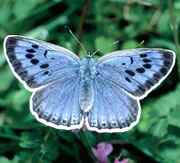British research suggests that animal species are disappearing around the world.
Michael Hopkin, Nature (translation: Dikla Oren)

Ecologists have presented solid evidence for the disappearance of many species of animals and plants around the world. Research into UK wildlife raises the possibility that insects, considered among the most resilient species on Earth, are becoming extinct at a rate similar to that of other long-studied large animals.
If this situation is indeed global, we may be witnessing the biggest extinction since the mass extinction that killed the dinosaurs, says Jeremy Thomas of the Center for Ecology and Hydrology in Dorset, UK, who led the study, published this week in the journal Science.
Thomas' group analyzed many studies, some from up to forty years ago, on birds, plants and butterflies in Britain. The statistics, collected by 20,000 amateur naturalists, create a "census" of insects with unprecedented accuracy. "No database has reached this level of detail anywhere in the world," says Thomas.
The researchers divided the territory of Great Britain into squares of 10 square kilometers and counted the number of squares that each species inhabits. Of fifty-eight butterfly species, 71% have declined or disappeared completely in the last twenty years. In the case of birds, the picture is quite similar, with 54% of the species reduced or disappeared. In the last forty years, a decrease of 28% of the studied plant species was seen.
Experts in the field estimated that the huge number of insects would protect them from mass extinction. "The gloomy result of the study is that the group of insects has been significantly reduced," says Thomas. Since insects make up more than 50% of the species on Earth, a major extinction means bad news for biodiversity, he adds.
Are we on the cusp of the sixth extinction?
"The study provides further evidence that the world is facing another major extinction crisis," warns Michael Rands, director of the British conservation group BirdLife International.
Five such mass extinction events have occurred on Earth since the birth of multicellular life about 600 million years ago. In each of them, between 65% and 95% of the species on the planet disappeared. No one claims that the disappearance of the various species has reached such levels, admits Thomas, but "the rate of disappearance is accelerating," he warns. "If we don't take different steps, many more species will be lost."
Thomas and his team attribute what is happening in Britain to the loss of habitats and breeding environments. Thomas says that the first line of defense against the disappearance of the various species will be the preservation of their habitats around the world.
Another study, published in Science, shows that another reason for the depletion of species, at least in the UK, is nitrogen pollution. A team led by Carly Stevens from the Open University in Milton Keynes in the United Kingdom examined sixty-eight prairie areas in the British Isles and found that where nitrogen pollution levels were higher, fewer animal species lived.
The soil in Great Britain and Central Europe absorbs an average of 17 kg of nitrogen per hectare (ten dunams) per year. Most of the nitrogen comes from the burning of fossil fuels and a lot of agricultural activity. Stevens warns that the pollution may kill about twenty percent of the species living in the prairie.
We must act now to stop it, she says. Once biodiversity begins to decline, it will be very difficult to prevent it from dying out completely. She says: "If you break enough bricks out of a wall, eventually it will fall apart."
